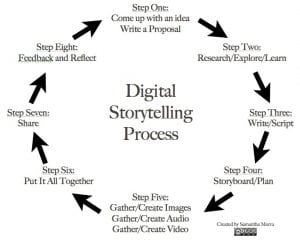Feb
2020
Sparking Student Creativity and Ownership: Digital Storytelling in Your Classroom

The Digital Storytelling Association defines digital storytelling as “the modern expression of the ancient art of storytelling. Digital stories derive their power by weaving images, music, narrative and voice together, thereby giving deep dimension and visible color to characters, situations, experiences, and insights” (Rule, 2018, 1). There are numerous benefits to having students create digital stories within the classroom, including engaging students in work around the 4 C’s: Critical Thinking, Creativity, Collaboration, and Communication. And, in eight easy steps, your students can create the next Gone With the Wind; ok, maybe not, but they will be super engaged in their learning and want to persevere until they have a great product. EdTech Teacher explains the 8 steps here.
Digital Storytelling in the Classroom
Digital storytelling takes your traditional project and gives it wings. Want students to write a narrative? Why not instead have them use multi-media to tell their story? Turn your typical boring book report into a digital review and ask you multimedia specialists to share student products on the library website so that other students can preview digital book reviews. Have students practice their world language skills by asking them to create a digital tour of a famous foreign city. Throw away your poster board and glitter glue and have students take the place of a character in a story they are reading via the digital world. Have your students use technology to interview grandparents or war veterans or their favorite animal. Take the time machine and your technology back to Verona and have students write digital love letters from Romeo to Juliet. The ideas are as endless as your imagination. Looking for some other great ideas, check out iSpring for using digital storytelling across several different content areas.
Where do you find digital storytelling tools?
There are numerous tools you can use within your classroom and more and more tools continue to be added. My favorite, very easy to use tools, are Animoto and PowToon. Both permit students to add graphics, sound, narration, video, and other effects. Lucky for you, I have gathered a list of even more web tools and apps that you can use in your classroom here.


